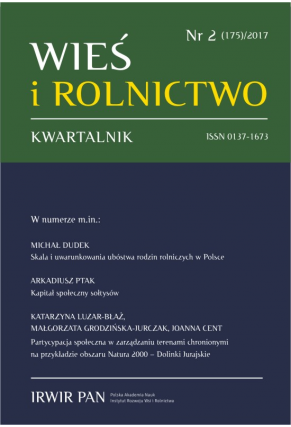Agriculture in the Persian Gulf Monarchies: Key Problems and Trends
DOI:
https://doi.org/10.53098/wir022017/05Keywords:
agriculture, Persian Gulf monarchies, Saudi Arabia, Bahrain, Qatar, Kuwait, Oman, United Arab EmiratesAbstract
The article elaborates on key problems and trends as well as constraints and opportunities which are observed in the agriculture of the Persian Gulf monarchies of: Bahrain, Kuwait, Oman, Qatar, Saudi Arabia and the United Arab Emirates. The Author tackles such problems as the influence of climate and geographic conditions on the development of agriculture in the above-mentioned states or the importance of water and land scarcity as limiting factors. The solutions which aim at minimizing negative effects of these factors are also included in the analysis. In the following sections of the article the Author describes the structure of agricultural land and the structure of agricultural production in the Gulf monarchies. Bearing in mind that agriculture should focus not only on its commercial function and economic dimension, the Author also pays much attention to its social and political aspects – which are important from both the perspective of the state policy as well as the daily life of its citizens. Due to the fact that all the monarchies of the Arabian Peninsula face food security problems, the relations between the agricultural production and food security are also the subject of the analysis. From the point of view of the Author, all the above-mentioned questions are of key importance for the agriculture of the GCC states.References
Arab Development Challenges Report 2011, UNDP.
Arias E., Hodder A.J., Oihabi A. (2016). FAO support to date palm development around the world: 70 years of activity. Emirates Journal of Food and Agriculture, 28, 1, 1–11. DOI: https://doi.org/10.9755/ejfa.2015-10-840
Danecki J. (2001). Arabowie. Warszawa: Państwowy Instytut Wydawniczy.
Danecki J. (2007). Podstawowe wiadomości o islamie. Warszawa: Wydawnictwo Akademickie Dialog.
Fronia M. (2010). Adaptacja do negatywnych skutków zmian klimatycznych. Znaczenie analizy kulturowej dla skuteczności projektów rozwojowych. W: Górak-Sosnowska
K., Jurewicz J. (red.), Kulturowe uwarunkowania rozwoju w Azji i Afryce (s. 351–364). Łódź: Wydawnictwo Ibidem.
Hasan S. (2012). The Muslim world and human development: An introduction. W: Hasan S. (red.). The Muslim World in 21st Century. Space, Power, and Human Development (s. 3–21). Heidelberg–London–New York: Springer. DOI: https://doi.org/10.1007/978-94-007-2633-8_1
Hitti P.K. (1969). Dzieje Arabów. Warszawa: PWN.
Huggett R. (2010). Physical Geography. The Key Concepts. London–New York: Routledge. DOI: https://doi.org/10.4324/9780203875674
Kantowicz E. (1999). Strefa sucha. Zasoby i zagrożenia rolnictwa. Warszawa: Wydawnictwo Akademickie Dialog.
Koran (1986). Tłum. J. Bielawski Warszawa: Państwowy Instytut Wydawniczy.
Kozanecka M. (1968). Rolnictwo na Bliskim Wschodzie. Kraków: Polska Akademia Nauk.
Kubursi A.A. (2015). Oil, Industrialization and Development in the Arab Gulf States. London–New York: Routledge. DOI: https://doi.org/10.4324/9781315744711
Łęcka I., Plit F. (2006). Afryka Północna i Azja Południowo-Zachodnia – tradycja i nowoczesność w świecie islamu. W: Makowski J. (red.), Geografia regionalna świata (s. 147–173). Warszawa: Wydawnictwo Naukowe PWN.
Makowski J. (2007). Geografia fizyczna świata. Warszawa: Wydawnictwo Naukowe PWN.
Oguamanam Ch. (2016). Sustainable development in the era of bioenergy and agricultural land grab. W: Alam Sh., Atapattu S., Gonzalez C.G., Razzaque J. (red.), International Environmental Law and the Global South (s. 237–255). Cambridge: Cambridge University Press. DOI: https://doi.org/10.1017/CBO9781107295414.012
Oman Salinity Strategy, Ministry of Agriculture and Fisheries, Sultanate of Oman, 2012, www.mfa.gov.om
Otok S. (2004). Geografia polityczna: geopolityka, ekopolityka, globalistyka. Warszawa: Wydawnictwo Naukowe PWN.
Pismo Święte Starego i Nowego Testamentu (2000). Poznań: Pallottinum.
Al Qaydi S. (2016). The status and prospects for agriculture in the United Arab Emirates (UAE) and their potential to contribute to food security. Journal of Basic & Applied Sciences, 12, 155–163. DOI: https://doi.org/10.6000/1927-5129.2016.12.23
Saudi Arabia, Grain and Feed Annual 2016, United States Department of Agriculture, Foreign Agriculture Service, www.gain.fas.usda.gov.
Shadid S.A., Ahmed M. (2014). Changing face of agriculture in the Gulf Cooperation Council Countries. W: Shadid S.A., Ahmed M. (red.), Environmental Cost and Face of Agriculture in the Gulf Cooperation Council Countries: Fostering Agriculture in the Context of Climate Change (s. 1–25). Heidelberg–London–New York: Springer. DOI: https://doi.org/10.1007/978-3-319-05768-2_1
State of Environment of the United Arab Emirates Report 2015, Ministry of Environment and Water, United Arab Emirates, www.moew.gov.ae
Wyszyński Z., Pietkiewicz S., Łoboda T., Sadowski M. (2008). Opracowanie metodycznych podstaw adaptacji produkcji roślinnej w gospodarstwach rolniczych o różnych typach gospodarowania i skali produkcji do oczekiwanych zmian klimatycznych. W: Sadowski M. i in. (red.), Zmiany klimatu a rolnictwo i obszary wiejskie (s. 51–62). Warszawa: FDPA – Fundacja na rzecz Rozwoju Polskiego Rolnictwa.
Zdanowski J. (2013). Historia społeczeństw muzułmańskiego Bliskiego Wschodu w XXI wieku. Warszawa: Wydawnictwo Naukowe Askon.
Źródła internetowe:
FAOSTAT, www.faostat3.fao.org
GRAIN, www.grain.org
International Center for Biosaline Agriculture, www.biosaline.org
Khalifa International Date Palm Award, www.kidpa.ae
Land Matrix, www.landmatrix.org
Ministry of Agriculture and Fisheries, Sultanate of Oman, 2012, www.mfa.gov.om
Ministry of Environment and Water, United Arab Emirates, www.moew.gov.ae
Oxfam, www.oxfam.ca
Secretariat General of the Gulf Cooperation Council, www.gcc-sg.org
Sulaibiya Wastewater Treatment and Reclamation Plant, www.udcsulaibiya.com
United Nations Development Programme (UNDP), www.undp.org
The World Bank, www.worldbank.org
Downloads
Article file downloads
Pages
How to Cite
Issue
Section
License
Copyright (c) 2017 Wieś i Rolnictwo

This work is licensed under a Creative Commons Attribution 4.0 International License.










